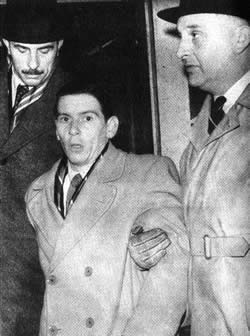Timothy John Evans: Difference between revisions
m Robert Brockway moved page Timothy Evans to Timothy John Evans |
No edit summary |
||
| (One intermediate revision by the same user not shown) | |||
| Line 1: | Line 1: | ||
[[File:Timothyevans.jpg|thumb|Timothy Evans, 1949.]] |
|||
[[Timothy John Evans]] (20 November 1924 – 9 March 1950) was a Welshman who was wrongfully accused of murdering his wife Beryl and infant daughter Geraldine at their residence in Notting Hill, London. In January 1950, Evans was tried and convicted of the murder of his daughter, and on 9 March he was executed by hanging. |
[[Timothy John Evans]] (20 November 1924 – 9 March 1950) was a Welshman who was wrongfully accused of murdering his wife Beryl and infant daughter Geraldine at their residence in Notting Hill, London. In January 1950, Evans was tried and convicted of the murder of his daughter, and on 9 March he was executed by hanging. |
||
Latest revision as of 03:16, 10 April 2024

Timothy John Evans (20 November 1924 – 9 March 1950) was a Welshman who was wrongfully accused of murdering his wife Beryl and infant daughter Geraldine at their residence in Notting Hill, London. In January 1950, Evans was tried and convicted of the murder of his daughter, and on 9 March he was executed by hanging.
During his trial, Evans accused his downstairs neighbour, John Christie, who was the chief prosecution witness in the case against him, of committing the murders.
Three years after Evans's execution, Christie was found to be a serial killer who had murdered several other women in the same house, including his own wife Ethel. Christie was himself sentenced to death, and while awaiting execution, he confessed to murdering Mrs. Evans. An official inquiry concluded in 1966 that Christie had murdered Evans's daughter Geraldine, and Evans was granted a posthumous pardon. The High Court dismissed proceedings to officially quash Evans's murder conviction in 2004 on the grounds of the cost and resources that would be involved, but acknowledged that Evans did not murder his wife or his daughter, a full 54 years after his wrongful execution by the British government.
The case generated much controversy and is acknowledged to be a miscarriage of justice. Along with those of Derek Bentley and Ruth Ellis, the case played a major part in the removal of capital punishment for murder in 1965 and, later, its abolition for all crimes.